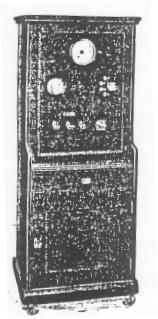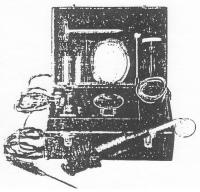
The therapeutic value of the high frequency current
depends upon a number of physical phenomena, some of which were known many
years before the high frequency was thought of.
In looking backward over electrical history, there are
three points that bear particularly upon the development of high frequency
therapy.
First: The invention of the Leyden jar, or an electrical
condenser; secondly, the discovery of what is known as electrical oscillation;
and finally, its application to the human body.
The Leyden Jar or condenser. The Leyden jar
was discovered in 1775 by Musschenbroek, and takes its name from the City
of Leyden. It consists of a glass jar covered on both the outside
and the inside with tin foil. (Fig. 7). These coverings only extend
part way to the top of the jar. A chain from the cover of the jar
connects with the inner layer, terminating above in a small rod with a
ball tip. This is for the purpose of charging the jar by contact
with the charging source or discharging it if this knob is brought nearly
or quite in contact with a metallic conductor touching the outer layer.
The peculiarity of the Leyden jar consists in the fact
that when a charge of electricity is placed on one of its layers, another
charge of opposite polarity immediately appears on the other layer of the
jar.
For instance, if the inner layer receives a positive charge,
a negative one will be found on the outer lead foil and vice versa.
These charges will be held for some time unless something
occurs to connect the two layers and allow the opposite kinds of electricity
to neutralize one another.
In the Leyden jar, then, we have two charges of electricity
separated from one another by the glass, which, although it keeps the charges
from getting to one another, does not prevent their exercising an attraction
upon each other; or, to speak more precisely, the one charge induces an
opposite charge on the other layer.


A substance which separates two charges of electricity
in a condenser while still permitting them to have an influence on one
another, is called a di-electric. Other di-electrics than glass are
mica, vulcanite, etc. The contraction of the charge on the layer
of the jar causes a crowding together or condensing of the electrical ions,
and thereby gives rise to the name condenser for the Leyden jar or the
other form known as the plate condenser.
In the plate condenser we have two layers of tin foil
separated by a plate of glass, thus keeping up the same relative arrangement
that exists in the Leyden Jar. To make the analogy more complete,
 |
 |
|
|
|

